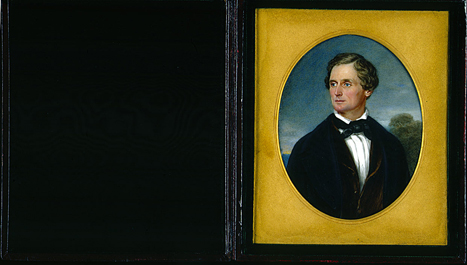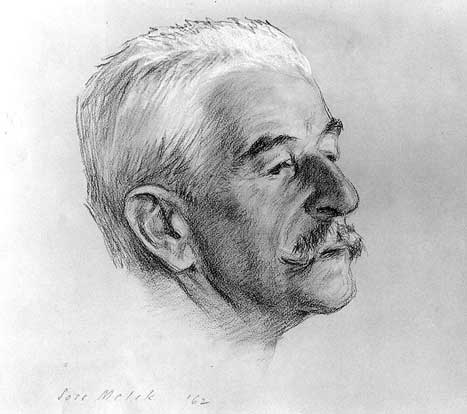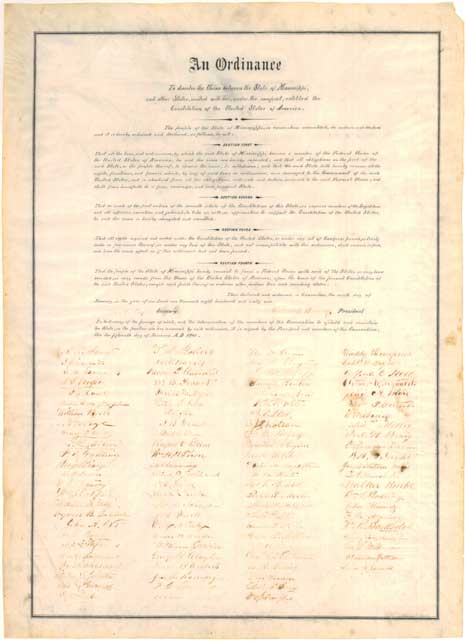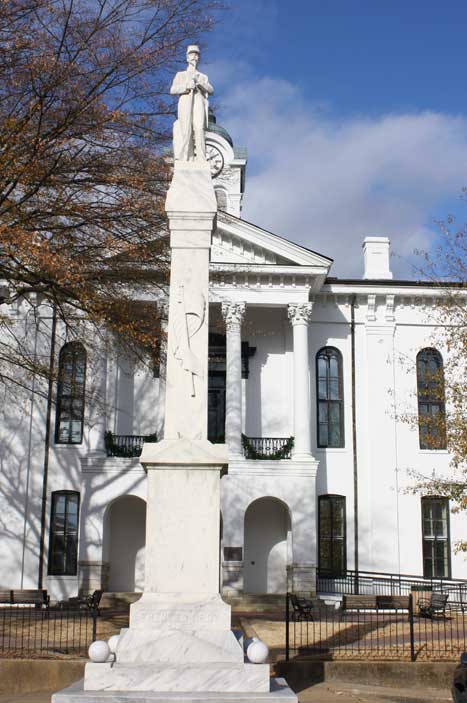Mississippi Joins South Carolina in Secession, January 9, 1861

"The people of the State of Mississippi, in convention assembled, do ordain and declare, and it is hereby ordained and declared, as follows. . . .That all the laws, and ordinations, by which the said State of Mississippi became a member of the Federal Union of the United States of America, be and the same are hereby repealed; and that all obligations on the part of the said State, or the people thereof, to observe the same, be withdrawn; and that the said State doth hereby resume all the rights, functions, and powers which, by any of said laws or ordinances, were conveyed to the Government of the said United States, and is absolved from all the obligations, restraints and duties, incurred in the said Federal Union; and shall from henceforth be a free, sovereign, and independent State."
— from "An Ordinance to Dissolve the Union between the State of Mississippi, and . . . the United States of America" [signed 15 January 1861, below]
The Union continued its dissolution on this date in 1861 with the secession of the state of Mississippi. As the nation moved toward war, one Mississippian in particular would be advanced to the highest echelon of the confederacy that would form over the next weeks. Previously a soldier, senator, and secretary of war, Jefferson Davis (above) believed that each state had the right to withdraw from the Union. When the Mississippi legislature voted to do so, Davis resigned from his United States Senate seat. He returned to his plantation in late January, only to be summoned to Montgomery to serve as president of the newly formed alliance of seceded states. Of this journey to meet his new office, Civil War historian Shelby Foote writes:
The train made many stops along the line and the people were out to meet him, in sunlight and by the glare of torches. They wanted a look at his face, the thin lips and determined jaw, the hollow cheeks with their jutting bones, the long skull behind the aquiline nose. . . . He brought forth cheers with confident words, but he had something else to say as well—something no one had told them before. He advised them to prepare for the long war that lay ahead. They did not believe him, apparently. Or if they did, they went on cheering anyhow.
At the war’s conclusion, Davis would spend time in jail while the United States government delved into the issue of what to do with him—was his crime treason, this leadership of open rebellion against the United States? Davis would eventually be released, return to Mississippi, and conclude his years writing memoirs of the war.
Although slavery was at the heart of the conflict, Mississippians like Davis also took the issue of states' rights seriously and mustered up rapidly for their cause. The war was waged most heavily in Virginia and Tennessee, but Mississippi hosted the siege of Vicksburg and many fights for control of the mighty river that runs the length of the state. Like every state on either side of the struggle, Mississippi also sent soldiers into battle, perhaps the most famous of whom were the University Greys, Company A of the Eleventh Mississippi Infantry. The Greys were made up entirely of young men from the student body of the University of Mississippi, and those who survived the war long enough to fight at Gettysburg were all either killed or severely wounded in Pickett's famous charge.

William Faulkner (above) alludes to the ill-fated hopes of these young soldiers in a famous passage from Intruder in the Dust:
For every Southern boy fourteen years old, not once but whenever he wants it, there is the instant when it's still not yet two o'clock on that July afternoon in 1863, the brigades are in position behind the rail fence, the guns are laid and ready in the woods and the furled flags are already loosened to break out and Pickett himself with his long oiled ringlets and his hat in one hand probably and his sword in the other looking up the hill waiting for Longstreet to give the word and it's all in the balance, it hasn't happened yet, it hasn't even begun yet, it not only hasn't begun yet but there is still time for it not to begin against that position and those circumstances . . . we have come too far with too much at stake and that moment doesn't need even a fourteen-year-old boy to think this time. Maybe this time with all this much to lose and all this much to gain: Pennsylvania, Maryland, the world, the golden dome of Washington itself to crown with desperate and unbelievably victory the desperate gamble, the cast made two years ago.
The Civil War and the impact of the enormous loss to Mississippi was a significant theme in Faulkner's work. In The Sound and Fury, Faulkner’s conclusion is embedded with symbols of decay of the old South, as Benjy, the idiot man-child, is driven backwards around the Oxford town square (below), an action provoking him to scream at the statue of the Confederate soldier. Faulkner's South never recovers from the massive catastrophe of the war.
— Warren Perry, Catalog of American Portraits, National Portrait Gallery
Special thanks to Chris Goodwin, director, public information, Mississippi Department of Archives and History, for his efforts to provide us with the copy of the Mississippi Ordinance of Secession.
Cited:
Faulkner, William. Intruder in the Dust
Shelby Foote, The Civil War: A Narrative
"An Ordinance to Dissolve the Union between the State of Mississippi and . . . .the United States of America" provided by the Mississippi Department of Archives and History
For further reading:
https://www.nps.gov/archive/gett/getttour/tstops/tstd3-21.htm

